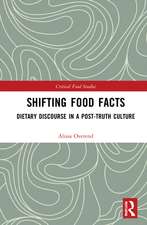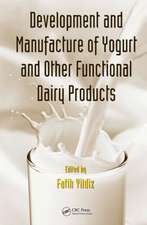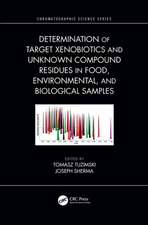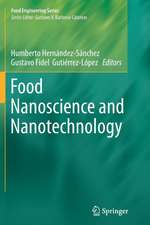Nanotechnologies in Food: Rsc Nanoscience and Nanotechnology, cartea 14
Editat de Qasim Chaudhry, Laurence Castle, Richard Watkinsen Limba Engleză Hardback – 28 feb 2010
Recent developments in the field of nanotechnology have paved the way for lots of innovation in a number of industrial and consumer sectors, including food and food packaging. Whilst nanofood sector is a relatively new emergent, it is widely expected to grow rapidly in the future. A number of nano-sized additives and supplements for food and healthfood products, and nanotechnology derived food packaging materials, are already available in some countries, and their number is expected to increase in the coming years. Whilst such developments offer enormous benefits to the food sector, they have also raised a number of issues in relation to consumer safety, environmental impacts, and ethical, policy and regulatory aspects. Despite these rapid developments in nanotechnology applications for the food sector, only a few reports and articles are currently available that provide an account of the new developments and the current size of market for nanotechnology products and applications. These also do not provide a critical evaluation of the broader aspects of the technology, such as issues around safety of the products to consumers and the environment, and adequacy of the existing regulatory controls. This book provides a source of much needed and up-to-date information on the products and applications of nanotechnology for the food sector - for scientists, regulators, and consumers alike. It also gives an independent, balanced, and impartial view of the potential benefits as well as risks that nanotechnology applications may bring to the food sector. Whilst providing an overview of the state-of-the-art and foreseeable applications to highlight opportunities for innovation, the book also discusses areas of uncertainty in relation to public perception of the new technological developments, and potential implications for consumer safety and current regulatory controls. The book also discusses the likely public perceptions of nanotechnologies in the light of past technological developments in the food sector, and how the new technology will possibly be regulated under the existing regulatory frameworks.
Preț: 860.83 lei
Preț vechi: 1000.97 lei
-14% Nou
Puncte Express: 1291
Preț estimativ în valută:
164.74€ • 171.36$ • 136.00£
164.74€ • 171.36$ • 136.00£
Carte tipărită la comandă
Livrare economică 12-26 aprilie
Preluare comenzi: 021 569.72.76
Specificații
ISBN-13: 9780854041695
ISBN-10: 0854041699
Pagini: 229
Ilustrații: 1
Dimensiuni: 155 x 234 x 18 mm
Greutate: 0.7 kg
Ediția:Edition.
Editura: RSC Publishing
Seria Rsc Nanoscience and Nanotechnology
ISBN-10: 0854041699
Pagini: 229
Ilustrații: 1
Dimensiuni: 155 x 234 x 18 mm
Greutate: 0.7 kg
Ediția:Edition.
Editura: RSC Publishing
Seria Rsc Nanoscience and Nanotechnology
Cuprins
Chapter 1: Nanotechnologies in the Food Arena: New Opportunities, New Questions, New Concerns; Chapter 2: The Evolution of Food Technology, Novel Foods, and the Psychology of Novel Food 'Acceptance'; Chapter 3: Public Perceptions of Nanotechnologies: Lessons from GM Foods; Chapter 4: Natural Food Nanostructures, Chapter 5: Nanotechnology Applications for Food Ingredients, Additives and Supplements; Chapter 6: Nanotechnologies in Food Packaging; Chapter 7: Potential Benefits and Market Drivers for Nanotechnology Applications in the Food Sector; Chapter 8: Engineered Nanoparticles and Food - An assessment of exposure and hazard; Chapter 9: Potential Risks of Nano Food to Consumers; Chapter 10: Small Ingredients in a Big Picture: Regulatory Perspectives on Nanotechnologies in Foods and Food Contact Materials; Chapter 11: An Outline Framework for the Governance for Risks of Nanotechnologies in Food; Chapter 12: Knowns, Unknowns, and Unknown Unknowns; Subject Index
Recenzii
"This book reveals opportunities for nanotechnology to develop innovative healthy foods and novel nutrient delivery systems."
"..provides rich information about current applications of nanotechnology in the food sector, nanoparticles’ potential benefits and risks, and regulatory issues in some developed countries. This book is a must-read for those who have interest in basics of nanotechnology and for those who are interested in deep discussion. The book has the potential to enhance public awareness and promote public communication in the applications of nanotechnology in food sector."
Notă biografică
Dr. Qasim Chaudhry Dr. Chaudhry is a Principal Research Scientist at the Food and Environment Research Agency (Fera) of the UK's Department for Environment, Food and Rural Affairs. He is also a member of the European Commission's Scientific Committee on Consumer Safety (SCCS), and a Visiting Professor at the University of Chester. Dr. Chaudhry is a Chemist and Biochemical Toxicologist by training. He currently leads a team of scientists at Fera who are undertaking research into the safety of nanomaterials to human health and the environment in a variety of products and applications, including food and food packaging. Dr. Chaudhry has published a number of research papers, review articles, and study reports on a range of safety and regulatory aspects of nanotechnologies. Dr. Laurence Castle Dr. Castle is a Principal Scientist in the Contaminants and Authenticity group at Fera. He and his co-workers have published more than 150 refereed journal papers dealing with chemical analysis of food additives and contaminants. Dr. Castle is an independent member of the CEF panel (contact materials, enzymes and flavourings) of the European Food Safety Authority and he was a member of the predecessor panel and working groups since 1996. He also has extensive experience working in other national and international risk assessment and standardisation groups including JECFA, WHO, DG-SANCO, CEN. CoE etc. Dr. Richard Watkins Dr. Watkins is Head of Environmental Risk Programme at the Food and Environment Research Agency (Fera). He leads a number of scientific teams that provide research and consultancy in risk management systems to assess and mitigate against the risks posed by conventional and emergent environmental contaminants (including nanomaterials). Dr. Watkins is author for over 40 peer-reviewed articles including two recent book chapters on food contaminants and the regulation for nanomaterials.
Textul de pe ultima copertă
Recent developments in the field of nanotechnology have paved the way for lots of innovation in a number of industrial and consumer sectors, including food and food packaging. Whilst nanofood sector is a relatively new emergent, it is widely expected to grow rapidly in the future. A number of nano-sized additives and supplements for food and healthfood products, and nanotechnology derived food packaging materials, are already available in some countries, and their number is expected to increase in the coming years. Whilst such developments offer enormous benefits to the food sector, they have also raised a number of issues in relation to consumer safety, environmental impacts, and ethical, policy and regulatory aspects. Despite these rapid developments in nanotechnology applications for the food sector, only a few reports and articles are currently available that provide an account of the new developments and the current size of market for nanotechnology products and applications. These also do not provide a critical evaluation of the broader aspects of the technology, such as issues around safety of the products to consumers and the environment, and adequacy of the existing regulatory controls. This book provides a source of much needed and up-to-date information on the products and applications of nanotechnology for the food sector - for scientists, regulators, and consumers alike. It also gives an independent, balanced, and impartial view of the potential benefits as well as risks that nanotechnology applications may bring to the food sector. Whilst providing an overview of the state-of-the-art and foreseeable applications to highlight opportunities for innovation, the book also discusses areas of uncertainty in relation to public perception of the new technological developments, and potential implications for consumer safety and current regulatory controls. The book also discusses the likely public perceptions of nanotechnologies in the light of past technological developments in the food sector, and how the new technology will possibly be regulated under the existing regulatory frameworks.
Descriere
This book provides an independent, balanced, and impartial view of the potential benefits and risks that nanotechnology applications may bring to the food sector.




























